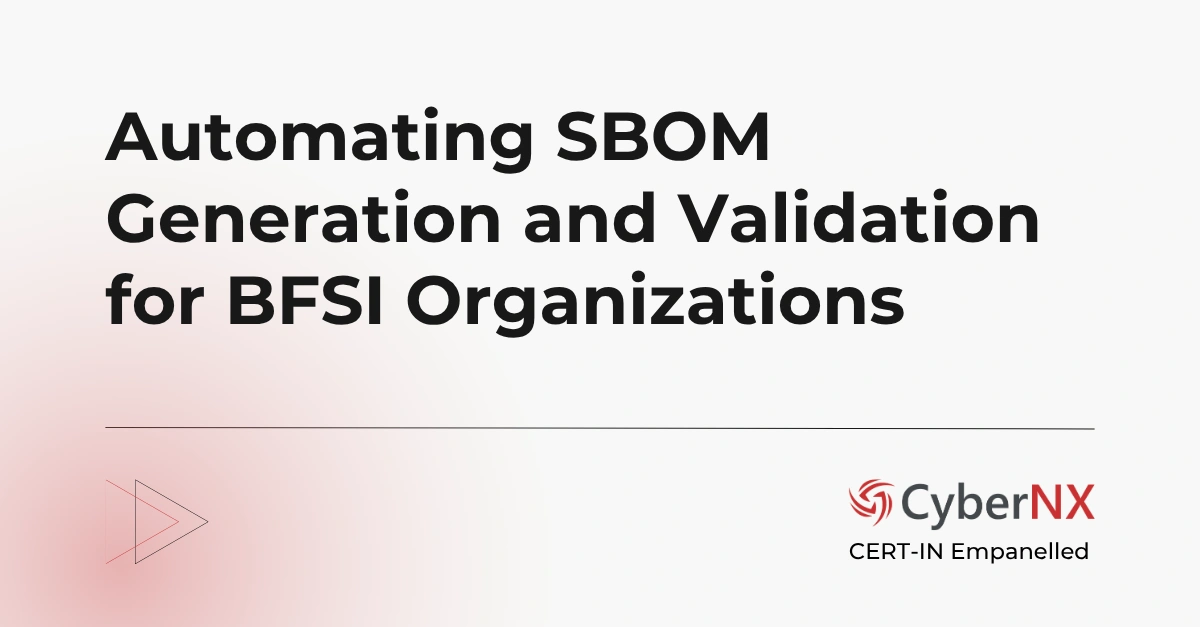SEBI’s Cybersecurity and Cyber Resilience Framework (CSCRF) has made Software Bill of Materials (SBOM) a mandatory element for core and critical applications used by SEBI regulated entities.
The requirement is detailed under standard 5 in the Governance: Cybersecurity Supply Chain Risk Management (GV.SC.S5) section of the CSCRF and its corresponding guidelines.
SBOM generation best practices for financial institutions must therefore go beyond a checklist. They must align governance, engineering and vendor management to deliver accurate, timely SBOMs that feed vulnerability management, third-party risk assessments and incident response.
SEBI’s CSCRF and subsequent FAQs define scope, timelines and the expectation that SBOMs cover for in-house, third-party, legacy and SaaS components. Plus, it mandates board/proprietary/partners approval where SBOMs cannot be produced.
Why SBOM matters under SEBI CSCRF
SEBI identifies software supply-chain visibility as essential to cyber resilience. An SBOM gives security and engineering teams a structured inventory of components, versions and origins so vulnerabilities (for example, a high-risk open-source CVE) can be traced to affected systems and remediated quickly.
SEBI CSCRF requires SBOMs for core and critical software and provides a clear path for regulated entities to achieve compliance.
Core problems financial institutions face
Financial institutions face multitude of challenges when it comes to SBOM generation such as:
- Fragmented inventories across lines of business and cloud/on-premise platforms.
- Manual SBOM creation that is error prone and stale by the time it reaches risk teams.
- Lack of SBOM standards or varying formats between vendors and SaaS providers.
- Poor mapping between SBOM data and vulnerability management, patching and procurement workflows.
These problems make detection and remediation slow, increasing exposure in a sector that is a high-value target.
SBOM generation best practices (Actionable)
SEBI’s CSCRF outlines numerous recommendations along with widespread requirements. Our experts after reviewing them have listed down functions that act as best practices for SBOM generation.
1. Treat SBOM as an engineering deliverable, not an audit artifact
Make SBOM generation best practices for financial institutions part of CI/CD. Generate SBOMs automatically on each build and on scheduled inventory scans for third-party software. Store SBOMs alongside artefacts (images, packages) in an immutable registry so the SBOM version maps to the deployed artifact.
Tip: Add SBOM generation to build pipelines (e.g. container image scanners, package manifest tooling) and fail CI when SBOM generation fails.
2. Adopt standard SBOM formats and schema mapping
Use SPDX or CycloneDX as primary formats to maximise interoperability. When vendors supply differing formats, normalise them into your canonical schema to enable automated correlation and reporting. This ensures SBOMs integrate with vulnerability scanners and GRC tools.
3. Define scope and classification tied to CSCRF requirements
Map SEBI’s “core and critical” definition to your application portfolio. Maintain a register that marks each application’s criticality, business owner, and SBOM cadence. For legacy systems where SBOMs cannot be produced, record formal board-level acceptance plus compensating controls as SEBI expects documented exceptions.
4. Include provenance, licensing and cryptographic evidence
Ensure SBOMs capture component source, checksums, supplier name, version and licence. Provenance data (where the component came from and how it was built) accelerates trust decisions and supply-chain investigations.
5. Integrate SBOMs into vulnerability and incident workflows
Feed SBOMs to your vulnerability management system so authorship of an exposed component maps to impacted services. During incident response, SBOMs shorten root-cause analysis by identifying vulnerable versions fast.
6. Automate telemetry and continuous reconciliation
Use periodic scans and runtime telemetry to reconcile deployed components against stored SBOMs. Drift detection – when runtime components differ from SBOM records – is a strong early warning signal.
7. Vendor contracts and SaaS procurement clauses
Add SBOM delivery SLAs and minimum format requirements into contracts. For SaaS, require vendors to provide SBOM exports or endpoint-level inventories; where unavailable, mandate monthly attestations plus compensating controls.
8. Governance, roles and auditability
Assign SBOM stewardship to a cross-functional team (security, engineering, procurement). Maintain an audit trail: who generated what SBOM, when, and which pipeline produced it. SEBI’s framework emphasises governance and board oversight – make SBOM reporting part of regular cyber risk dashboards.
Tooling and standards to consider
Here are some tool and standards to factor in while generating SBOMs:
| PURPOSE | RECOMMENDED APPROACH |
| SBOM production | SPDX or CycloneDX; build plugins for Maven, npm, pip, Docker |
| Component scanning | SCA tools that ingest SBOMs (open source and commercial) |
| Provenance & attestation | Signed SBOMs (cryptographic signing) |
| Policy & gating | Policy-as-code to block components with high-risk licences or CVEs |
Also review CERT-IN technical guidelines for SBOM, QBOM and HBOM to align across software and hardware inventories.
Measuring success
Can you measure the success of SBOM generation? Yes, you can with these key metrics to track:
- Percentage of core/critical apps with up-to-date SBOMs.
- Mean time to identify affected assets after a CVE (goal: hours not days).
- Number of vendor contracts updated with SBOM clauses.
- Percentage of SBOMs generated automatically vs manual.
Conclusion
Implementing SBOM generation best practices for financial institutions under SEBI CSCRF is both a compliance activity and a strategic improvement to cyber resilience.
Automating SBOM production, standardising formats, embedding SBOMs into vulnerability and procurement workflows, and enforcing governance offer key benefits. Financial institutions can reduce time to detect and remediate supply-chain risks.
Begin with high-value assets, instrument CI/CD and vendor contracts, and iterate based on measurable outcomes. For tailored implementation and compliance support, our experts can help design the pipeline, normalise SBOMs and integrate them with your existing GRC and security operations.
Ready to operationalise SBOM at scale? Our SBOM management with in-house built SBOM tool has helped myriad businesses across India to comply with SEBI CSCRF. Book a consultation with our experts today.
SBOM generation best practices for financial institutions FAQs
Does SEBI require SBOMs for SaaS products used by regulated entities?
SEBI’s CSCRF expects SBOM coverage for core and critical software, which includes SaaS where it supports critical functions. If vendors cannot provide an SBOM, the RE must document exceptions and compensating controls per SEBI guidance.
Which SBOM format should we choose?
Use SPDX or CycloneDX – both are widely supported. Normalise incoming vendor formats to your canonical schema to enable automation and analytics.
How often should SBOMs be regenerated?
Automate SBOM generation on every build and run scheduled full-stack scans (weekly or monthly) for third-party/SaaS inventories; increase cadence for critical systems. The goal is near-real-time alignment with deployed artefacts.
Can legacy applications be exempted from SBOM requirements?
If generating an SBOM for a legacy application is not feasible, the institution should obtain board-level approval for the exception and implement compensating controls as prescribed in the SEBI FAQs. However, it must still maintain component-level inventories and apply enhanced monitoring for such systems.





